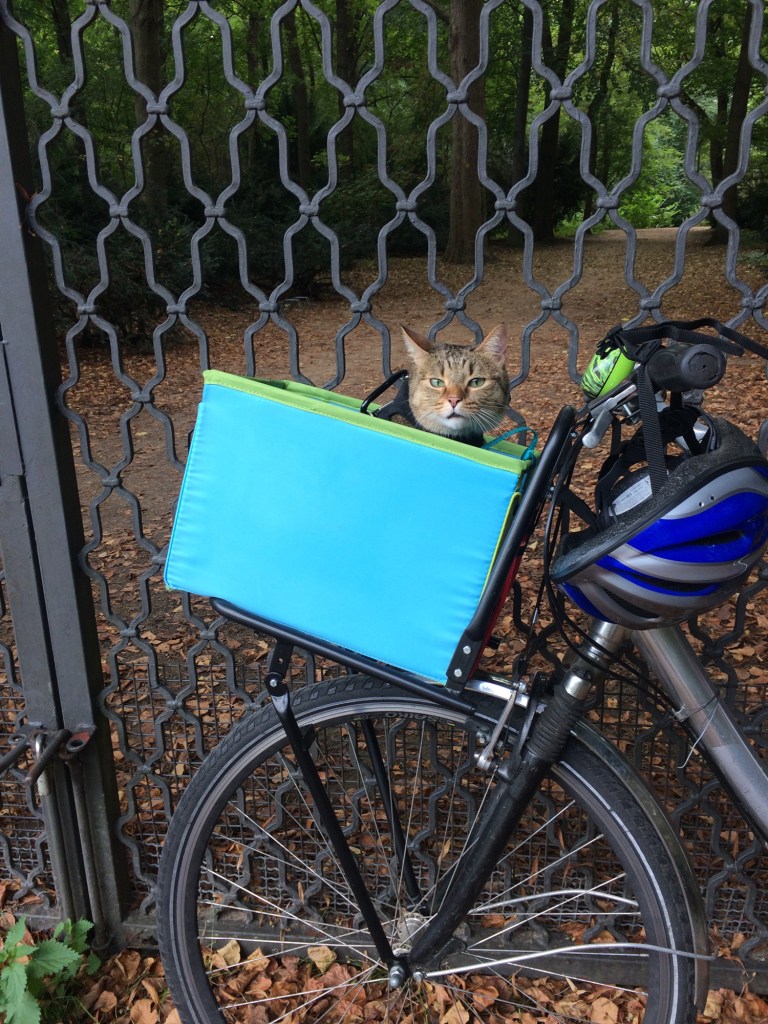Editor’s note on July 2, 2019: No two cats are the same. Some felines may love accompanying humans on adventures, while others may be more comfortable close to home—in the sunniest spot in your apartment, if possible. Pay attention to your pet and cease outdoor activities if you notice signs of stress.
We all want to be outside whenever we have the chance. Those of us with dogs will often bring them along to share the adventure. But what if our best four-legged friend is a cat?
Cats are usually either left to roam as they please or kept locked up in the house, but they’re almost never trained to join the fun. However, in the last few years, cat owners have begun harnessing their cats and bringing them along on adventures. A quick search of social media reveals scores of cat-human duos hiking, kayaking, cross-country skiing, sailing, cycling, mountain climbing, road-tripping, camping and even surfing together.

Interested in getting your cat out on the trail? It’s tricky, but it can be very rewarding. I’ve learned a lot from taking my cat, Aífe, on outings that I want to share some tips I’ve discovered. I checked in with REI employee, Amanda MacLeod, and her fiancé, Dan Borowski, to hear about their experience of training their two cats, Leo and Beta.
Here are a few tips for getting your adventure cat ready to hit the trails:
1. Get a really good harness.

Photo Credit: Amanda MacLeod
Cats’ bodies often seem to be made of putty, and if their harnesses don’t fit just right, they can wriggle right out of them. Only a few companies are making harnesses specifically for cats, but many harnesses designed for small, Chihuahua-size dogs also work great for cats. Choose a harness with wide fabric panels, rather than just a couple of thin straps; these harnesses will be a lot harder for your cat to escape from. This is especially important because it’s very hard to get cats to respond to commands, the way dogs do. As Dan and Amanda put it: “Most cats do not follow you like dogs. They want to travel at their own pace and go where they want to (at least our cats!).”
2. Start out slow.

Photo Credit: Amanda MacLeod
Don’t just scoop your cat up one day and plop her out in the open. Helping your cat adjust to walking on a leash and outdoor stimuli is an ongoing process. Dan and Amanda have had similar experiences training Leo and Beta: “Slow, methodical exposure to the new harness and the outdoors is your best tool.” Let your cat get used to hanging around the house in her harness, let her sniff at and sleep on her gear. If you have a yard, try walking your cat on-leash out there, so she can get used to the idea in a safe place. If you don’t have a yard, nearby parks are great alternatives. Start mellow, and build from there.
Also, it’s actually way easier to get a cat to walk up a mountain than around a city block. Even after years of constant practice, my cat can still get stressed just walking a few city blocks. On the other hand, the very first time I took her out on a hike, she hit the trail running.
3. Be aware of threats to your cat’s well-being.

Depending on where you’re headed, there may be some big threats to cats, such as eagles, coyotes and mountain lions. Mostly there will be lots of tiny ones, like fleas, ticks, worms, mites and giardia. Make sure to check what large and minuscule wildlife are prevalent in the area you’re headed, and at what times of year.
You’re also likely to encounter dogs in most places—and those dogs may be excited to see your cat. Dan and Amanda confirm this: “Dogs will always be on the trails, and despite the laws they will often be off-leash running around and having fun. While this does not bother us, our cats are not fans! You always have to keep your eyes scanning for potential problems ahead or behind.”
4. Get a good pack.
Once your cat gets used to being outdoors with you, she will enjoy covering some trail on its own paws. But those are tiny paws, at the end of short legs. Cats are built to move very quickly in short bursts, rather than trudging along for miles like our bipedal selves. Even the bravest, sturdiest cat is almost certainly going to need carrying some of the time.

You can re-purr-pose pretty much any good pack. When I first started taking my Aífe out and about, I used the only daypack I had—a little REI Co-op Flash 18. It worked fine, except the drawstring opening on that pack is narrow, and whenever she jumped out to walk around, it was really hard to get her back in. So I upgraded to the REI Co-op Trail 25. Find a pack with comfortable shoulder straps to bear the load of your regular items in addition to the weight of your cat. It’s best to have a pack that unzips most but not all the way down, so there’s enough closure to hold her in but can allow for an easy escape when she wants to.
When you’re out on the trail, don’t forget to practice Leave No Trace principles and make sure to attach your cat’s leash to the pack. You’ll also want to stash some poop bags in one of the outer pockets.
The great outdoors might not be for every cat, but with enough persistence, patience and love, your cat might really surprise you. Mine certainly has. And watching her explore and grow has been the one of the most joyful, rewarding experiences of my life. In my opinion, it’s worth trying.
Happy trails!
